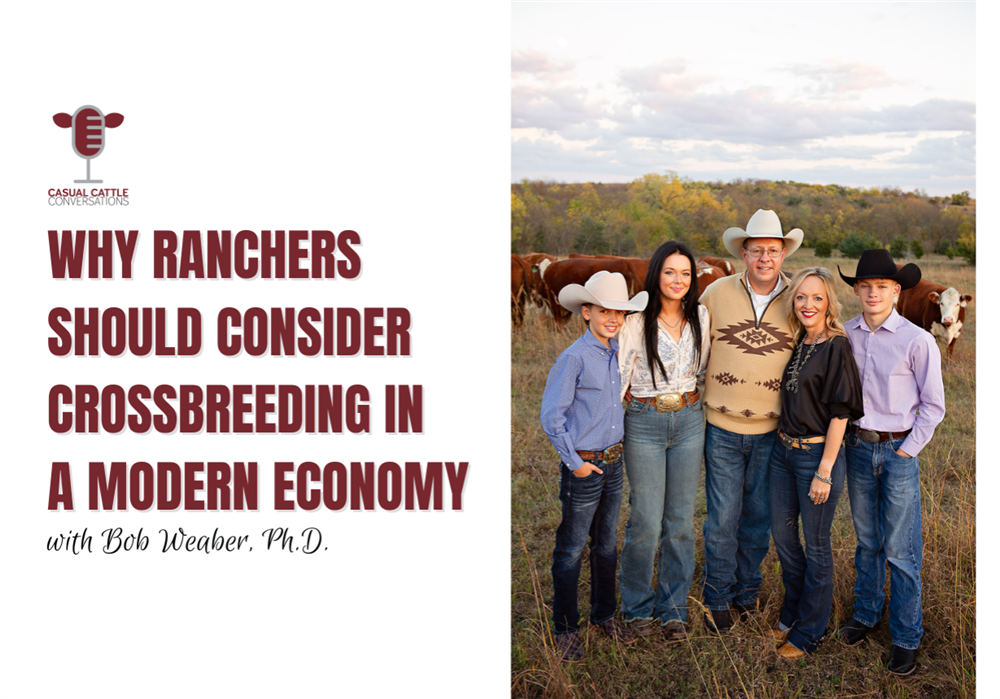The Casual Cattle Conversations Podcast: The Value of Crossbreeding in a Modern Economy
Thursday, January 9, 2025
Reference: Podcast Corner

The Value of Crossbreeding in a Modern Economy
January 6, 2025 | Written By Shaye Koester
The challenge of navigating input costs is a familiar one to ranchers across the country. While there are numerous approaches to managing inputs, one that can’t be ignored is genetic selection. Genetic selection impacts efficiency, longevity, and performance in your cow herd and calf crop. It’s the foundation of your herd and operation.
A proven genetic selection strategy cow-calf producers can leverage to increase the value of cows and calves while increasing efficiency is strategic crossbreeding. Crossbreeding can be beneficial for operations of various sizes with different marketing goals. However, ranchers must have a similar mindset about crossbreeding to be successful no matter how different their operations are.

Click Here to listen to Shaye's Podcast
“The two questions ranchers need to ask before they start crossbreeding are am I really in the beef business to make money and as a manager, am I willing to be committed to the process and stay focused on the objectives,” says Bob Weaber, Ph.D. – Professor and Extension specialist at Kansas State University.
Without a strategy, crossbreeding can detract from the value of calves and create marketing challenges. But, with a strategy, crossbreeding has shown increases in growth rate starting in utero, calf survival rate, immune function, average daily gain and longevity in cows.
Weaber says, “The real economic advantage of a crossbreeding system comes from having crossbred cows.” The increased longevity, offspring performance in efficient utilization of feed is a testament to both system profitability and sustainability.
The increase in value heterosis brings to the maternal component of a ranch system may shock some cow-calf producers.
“Last spring producers were getting $2.75 for 5 and 6-weight calves in Salina, KS which is higher today. At that price, the additional heterosis benefits were worth just short of $300 per cow. That $300 would move you from the bottom quartile to the top quartile of profitability according to CattleFax’s Cow-calf summary data,” says Weaber.
This significant change in value requires focus and strategy to be obtained. Ranchers need to know their marketing objectives in the short and long-term as well as what areas they can improve their cowherd.
“It’s really easy to get focused on carcass endpoint. That’s a huge part of our business and I don’t want to take away from the importance of those dollars. But, if we have to trade off a whole bunch of maternal performance to get there at the individual enterprise level we may not be optimizing the profit potential of the ranch,” says Weaber.
There are a multitude of methods to experience the benefits of strategic crossbreeding. Outside of marketing endpoint, operation size is another key factor to consider before picking a plan. “What works for someone with 50 cows may not work for someone with 500 or 5,000 cows and vice versa,” says Weaber. Pasture size and availability also plays a role in the best system for operations.
Larger operations who utilize large pastures on BLM land, can garner the benefits of a three or four breed composite system or even a three breed rotation. However, smaller operations can get better bull utilization out of utilizing hybrid bulls or buying maternal replacements and mating them terminal. The latter method has been proven valuable by the pork and poultry industries.
Weaber says, “When we think about crossbreeding systems, it’s important that we also strategically interject breeds at the right spot to leverage the additive genetic merit that comes into play.”
Producers need to think through how they can get the right bulls with the right cows cost-effectively.
Other tools to aid in effective crossbreeding systems include artificial insemination and the use of gender sort semen. Gender sort semen reduces the likelihood of raising maternally oriented bulls or steers or terminal heifers for those raising replacements.
Crossbreeding isn’t clean cut in terms of which systems are best, but it is undoubtedly advantages for commercial cattlemen who are committed to the process of improving the input and output relationship for the overall system of their operation.
Find Your Next Herd Sire: https://bit.ly/bullpen-ccc
Connect with Bob: bweaber@ksu.edu https://ebeef.ucdavis.edu/
Bob's Slides: https://bit.ly/CCC-resources
Goal-setting System for Ranchers: https://www.casualcattleconversations.com/ranchermind-events/p/move-the-ranch-forward-2025
Sign up to stay connected
- News
- Property Alerts
- Save your favourite properties
- And more!
Joining Farm Marketer is free, easy and you can opt out at any time.
